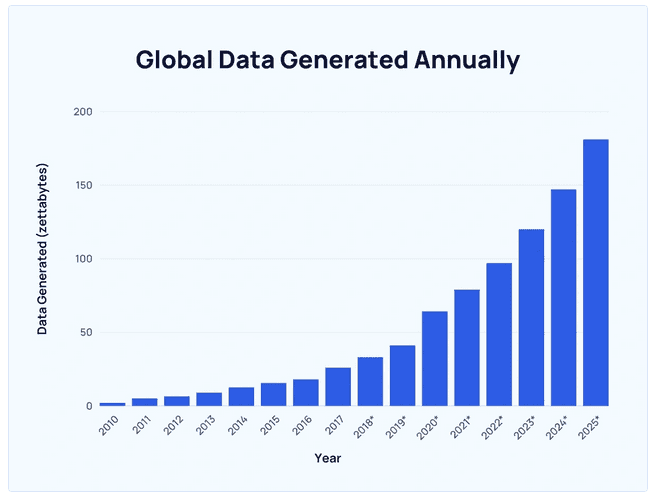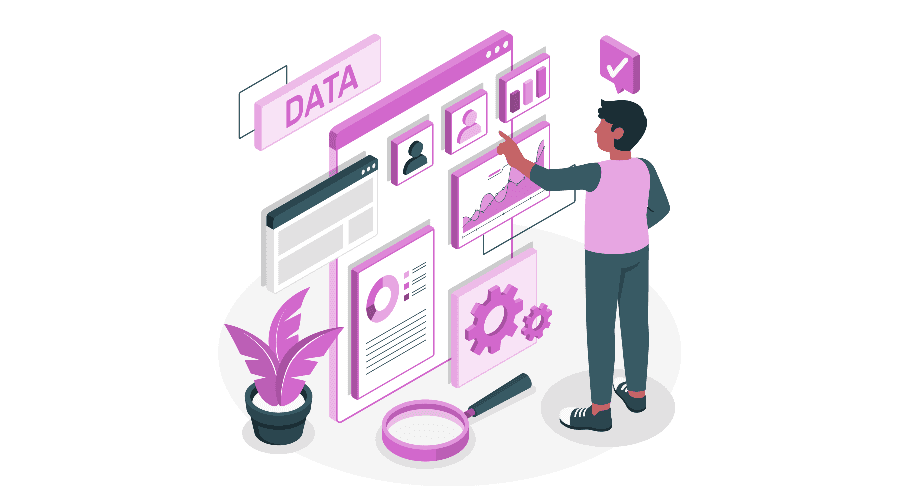Did you know that data-led organizations are 23 times more likely to acquire new customers than those that don’t rely on data? That’s right. Data plays an integral part in the success of any business. It helps to predict trends, discover new opportunities, and outperform competitors.
Although essential, many organizations are grappling to capture and process data efficiently. Being able to comb through the mounds of raw data and draw meaningful insights takes work. This is where technologies like intelligent document processing (IDP) come in handy.
IDP is a smart software designed to read, classify, and extract vital information from different sources. If you run a business that relies heavily on data, this article will teach you how to make the most of IDP technology.
What Is Intelligent Document Processing (IDP)?
At its core, IDP is a business automation technology designed to process and manage unstructured data.

Source: Statista
As the chart shows, the data generated by organizations has been increasing steadily over the years. In 2010, the total amount of data was just two zettabytes.
In a span of 13 years, this figure had risen to 120 zettabytes, representing almost 60x increment. Furthermore, it’s projected to reach 181 zettabytes of data by 2025.
Unfortunately, most of this data is locked in text, PDFs, emails, and other unstructured forms. This poses a challenge for businesses trying to process it.
IDP technology comes into play, transforming unstructured and semi-structured data into structured data for easier processing. Without it, companies would have to hire dozens of workers to review every document and extract data manually.
Thankfully, IDP solutions eliminate this time-consuming task. Using AI, the IDP systems scan, read, organize, and extract vital information from multiple unstructured sources. So, how exactly do IDP solutions work? Well, here is a detailed breakdown of this:
How Does IDP Work?
IDP blends several technologies to analyze and extract information from unstructured, semi-structured, and structured documents.
These technologies include Natural Language Processing (NLP), Machine Learning (ML), AI, computer vision, and Optical Character Recognition (OCR). Here are the key steps that take place during intelligent document processing:
Document Ingestion
This is the first stage of IDP, which involves obtaining data from various sources. As stated earlier, a key selling point of IDP is that it supports data processing regardless of the source. So, whether you have hardcopy documents, emails, or scanned text, IDP technology allows you to upload them to the system.
Optical Character Recognition
Once the documents are uploaded, they’re exposed to OCR. This technology is responsible for converting them into a machine-readable form. It enables computers to detect specific characters and words within documents.
Data Extraction
This stage entails extracting meaningful data using machine learning algorithms. These algorithms can be configured in a way that allows them to identify specific categories. For instance, they can spot names, addresses, dates, and other details.
Contextual Understanding
If there’s one thing that makes IDP unique, it’s the capacity to grasp the context of a document. The system uses advanced technology like NLP to decipher relationships between data variables and their relevance within the document’s context. This increases the precision level of the data being extracted.
Data Validation
This step aims to verify that the extracted data is accurate. The data is usually evaluated against some predetermined rules or current databases to achieve this.
It’s important to note that this validation occurs within the system; no human intervention is needed.
Data Classification
After the data is verified, it’s categorized according to relevance and scope. For instance, let’s say the document in question was an expense receipt.
The IDP system would generate meaningful data points, such as the date, receipt number, location, and sum of money. Typically, the nature of information displayed on such a document is unstructured. So, in such situations, the platform can be trained to identify specific types of documents as “receipts” and classify them accordingly.
Data Enrichment
At this stage, the data is pretty much ready to use. This means it’s easy to understand and draw meaningful conclusions from it. However, it can be enriched further. This can be done by incorporating information from secondary sources and conducting calculations or analysis.
Data Export
Once content with the enriched data, you can easily send it to existing business applications. This could be your Customer Relationship Management System (CRM) or Enterprise Resource Planning (ERP) system.
Benefits of Intelligent Document Processing
here are the key benefits of intelligent document processing:
Increased Operational Efficiency
A key benefit of any IDP technology is the fact that it eliminates the need for human intervention. This is particularly useful in processes involving tons of documents, as recording and processing them manually can be very time-consuming.
IDP systems are designed to scan, convert, extract, sort, and index vital information from structured and unstructured sources in minutes! Imagine how much time paralegals could save by deploying IDP to process, index, and file evidence documents. Or accounting departments utilizing IDP solutions to record and reconcile sheer volumes of invoices.
Better Precision
Research shows that the likelihood of making errors when entering manual data falls between 18% and 40%. Plus, this only applies to simple spreadsheets and paperwork. If you’re dealing with complex spreadsheets you barely understand, this likelihood increases to 100%.
With data being the backbone for most business processes, you’ll want to process it correctly. Deploying IDP technology significantly cuts down this risk of error, thus increasing the accuracy of data processing results.
Company-Wide Automation
Whether you run a small- or large-scale business, it’s likely that different departments generate different types of data.
The quantity and variation in data formats can make processing such information difficult. This, in turn, makes it difficult for relevant stakeholders to make informed strategic decisions.
IDP solutions let you convert all your company data into a format everyone understands. Whether the information was obtained from hand-written notes, images, or Excel spreadsheets, it’s processed and analyzed to generate user-friendly input. This way, all appropriate parties have access and can understand the data easily.
Cost Savings
IDP technology is the ultimate solution if you’ve been looking for ways to minimize business costs.
These systems eliminate manual, repetitive tasks like manual data entry or verification. This reduces the work hours needed while allowing employees to focus on more important business functions. Some companies have reported up to 70% cost savings by leveraging IDP.
Improved Security
Most IDP systems come equipped with premium security features. This prevents unauthorized access to sensitive business/customer data and minimizes the risk of security breaches and cyberattacks.
It also reduces the chances of losing essential data, which can be a major setback for data-reliant organizations. Besides, this fosters trust in clients, employees, partners, and other company stakeholders.
Key Features of a Modern Document Processing Platform
Are you a business owner hunting for document processing software? If so, there are several key features you should consider, namely:

Automated Data Extraction and Analysis
One of the primary reasons for investing in a document processing platform is to enjoy automation benefits. As such, you should look for IDP solutions that deliver just that. They should be capable of automating data-related tasks, starting from recording to analyzing, extracting, and processing.
Seamless Integration
A good IDP solution is one that integrates seamlessly with your company’s current IT infrastructure. This offers two main benefits. For one, it ensures that you’ll have a smooth transition to the IDP system. Secondly, it prevents disruptions to current business processes.
So, if you have to start modifying your customer database or compliance systems before you can implement it, then it probably isn’t the right fit.
Scalability
Scalability is another feature present in modern document processing systems. This ensures that the IDP system remains relevant when/if your business expands. Simply put, it should handle increasing volumes of documents and data as your firm grows.
Data Security
One of the most crucial elements of any IDP solution is data security. The technology provided should have solid security protocols to protect sensitive data or confidential documents. Access controls, encryption, and secure storage are vital to protect your company against breaches.
Flexibility
The best IDP solutions can handle pretty much any type of document. This is a crucial feature as most businesses generate all sorts of unstructured data. These range from online form submissions to emails and handwritten notes, just to mention a few.
Modern document processing platforms are flexible enough to handle all types of documents. Some IDP solutions can even reveal the intent or context of the document, further streamlining customer support services.
Developing Your Intelligent Document Processing Platform
Are you looking to develop an IDP solution for your enterprise? If so, here are a couple of steps you should consider:
Assess Your Business Needs
Start by evaluating the individual needs of your business. Examine your current document processing platform and determine the immediate demands or challenges. Ask yourself, “Which documents or tasks take up the most energy and time?” This is the area where you should integrate the IDP solution first.
Choose the Right Tech Stack
Once you’ve determined your business needs, it’s time to pick your tech stack. As stated earlier, implementing IDP solutions involves several technologies like NLP, AI, computer vision, and machine learning.
Depending on the intended application, you may only need one or more of these technologies. If you’re unfamiliar with these components, consider working with a tech expert to help you choose wisely.
When picking the IDP solution, remember to consider factors like ease of integration, compatibility, scalability, and data security.
Pilot Implementation
Now that you’ve chosen your IDP system, the next step is to test-drive it. With the help of your IT staff, gradually implement the technology in your business processes.
I’d recommend first integrating it in a few tasks to gauge its performance. This way, you can fix potential hurdles at a small-scale level. Besides, this makes it easier to collect feedback from relevant parties.
Staff Training
Once you’ve gotten the hang of how the system works, loop in your workers by training them. Provide adequate training resources and continued support. This makes for a smooth company-wide transition while maximizing potential benefits.
Monitor and Adjust
Like most smart systems, IDP solutions are designed to improve continuously by evaluating past patterns. As such, it’s good to monitor the system closely, making necessary tweaks to achieve a flawless operation.
You can record your own data regarding the system’s performance to gain valuable insight. This way, you can determine the adjustments needed to improve its operation in the future.
Stay Updated
IDP technology is always evolving. You might find advanced features in modern IDP solutions that weren’t available in previous systems. For this reason, it’s important to keep abreast with the latest trends and advancements. This helps your business remain relevant and stay ahead of the curve.
Build a Powerful Custom IDP Solution with Imaginovation
Intelligent document process is an excellent remedy for any enterprise looking to streamline its data extraction system. Using AI, machine learning, NLP, and other technologies, it efficiently scans data, converts it into machine-readable form, processes and extracts vital information.
If your enterprise is looking to jump into the world of IDP, Imaginovation can help. We will help you spot the business processes that could benefit the most from IDP solutions. We will also assist you in developing a custom IDP solution and integrating it into existing IT infrastructure.




